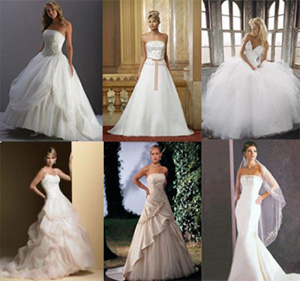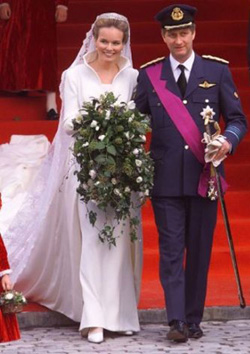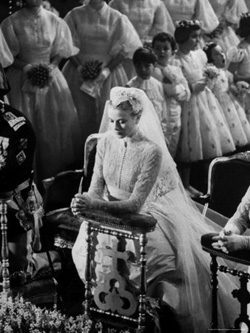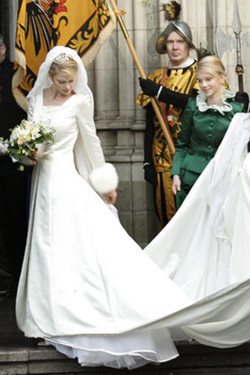 |
Manners, Customs, Clothing
Questions on Bridal Wear
Countering Modern Trends in Wedding Gowns
Marian T. Horvat, Ph.D.
A letter from a fashion designer and illustrator who is trying to follow Catholic principles arrived in my mail. It was a happy surprise. Miss R.X., who specializes in bridal wear, thanked me for my past articles on fashion and asked if I would elaborate on the topic. It is June, the month of brides, and I am glad to respond to her questions, which I have summarized and placed in a Questions/Answers format.
1. Question: It seems to me that today the sacramental emphasis of marriage is downplayed in Holy Matrimony. Emphasis for the bride is directed on a wedding gown, and the designers are making dresses that are immodest and inappropriate to wear in Church. I’d really like to know what you think about what brides should wear.

In vogue - the strapless wedding dress |
Answer: The bridal gowns that are in fashion today are dresses that are completely inappropriate to wear not only in Church, but anywhere in public. If you look at a Brides magazine or search the web with “wedding dress,” you find pages and pages of strapless dresses. It is clear that the “blushing bride” is considered a thing of the past.
Apparently, the modern young woman has become so accustomed to exposing her body that she thinks nothing of brazenly displaying it even at the altar before Our Lord in the Blessed Sacrament on her wedding day. How ironic that, on the day the virgin bride should be revealing her body only to her husband for the first time, she reveals a good part of it instead for the whole world to see.
I think, however, the blame is misplaced by singling out bridal wear designers as the first culprits. There are more culpable parties here. The designers are, after all, ultimately dependent on public demand as well as on the pocketbooks of the parents of brides who finance the wedding.
Let me say a word about the guidelines the Church used to provide. I have a friend who was married 20 years ago. She and her fiancé went to see the parish priest, who made it clear at the first meeting that she should have an appropriate wedding dress. “No sleeveless, no low neck or back, no sheer material,” he told her. She was a bit miffed at the guidelines, she told me, but later she was very grateful that her wedding dress had been modest and an appropriate example for her children.

Above, Princess Mathilde sets a good example for Belgian brides. Below, the marriage of France's Duke of Anjou with the Duchess of Cadavel from Portugal
 |
Today, couples meet to go over elaborate wedding plans at the “parish center.” There are guidelines and rules for almost everything – throwing rice, floral arrangements, pew decoration – but nary a word about the bride’s wedding gown. This is a grave omission on the part of the parish priest, who should take every initiative to protect modesty and restore Catholic Morals.
Speaking to the Bishops of the world in the Marian year 1954, Pope Pius XII warned them of the dangers of exposing not only “thoughtless youth,” but even adults to the “immoral public spectacles” that were becoming so common. This certainly describes the apparel worn by so many brides and bridesmaids today. For this reason, he affirmed, it is necessary “to throw a true light upon the beauty of modesty and exhort all to it, and, on the other hand, to hinder and prevent as much as possible all that incites to evil.”
“Finally,” the Pope insisted, “it is necessary – even with severity – to lead the world back to good morals. … Now, as all can see, modesty is being gravely sinned against in the manner of dress, especially of women and girls.… Hence it is absolutely essential to warn and exhort every class of society – and especially youth – to abjure these great dangers that are indubitably contrary to Christian and civic virtue and which lay them open to the greatest perils.”
These words, true and applicable then, remain so today. Modesty of dress must always be preserved, regardless of the epoch, place or culture. Therefore, the priest has an obligation to insist that modest apparel be worn by the bride and other members of the bridal party.
Next, let me stress that Catholic parents must assume blame for the immodest wedding gowns of their daughters. How many parents cave in to the demands of daughters who insist that they should wear the latest style of wedding gown, which is, unfortunately, gravely immodest? Sadly, many.
“But you can’t find modest dresses,” the daughter may whine and protest. It is a poor excuse. In fact, you must look harder, but you can find elegant and most appropriate dresses if you are willing to make the effort.
Statistics show that 22% of our American population is Catholic. This constitutes a significant number. Indeed, from the general population of 300 million, there are around 66 million Catholics - more than the entire population of the U.K. (60 million), France (60.9 million) or Italy (58.2 million). So, let’s set aside the old story that we live in a Protestant country. Yes, it still has a majority of Protestants if you put all the sects together, but the Catholic Church has become the largest denomination in this country. We have a voice, and it should be heard. We should be calling for a healthy morality. We have enough American Catholics to demand appropriate fashions of our own.
If a good portion of American Catholics young women were being wisely advised by priests about wedding apparel and guided by parents following Catholic Morals, there would be a strong market for modest, elegant bridal apparel. I am sure there would be designers who would respond to that demand and begin to provide more suitable wedding gowns.

Brides around the world copied the elegant gown and veil of Grace Kelly |
2. Question: Looking back at the wedding dress worn by Grace Kelly on her wedding day, we see how times have truly changed, and not for the better! Why don’t we see famous persons following the old traditions?
Answer: You bring up a very important point that Americans, because of the dominant egalitarian spirit, are often loathe to acknowledge - it is the upper classes that set the trends. What they wear, how they act, their manners and ways of being are watched and copied by others.
For this reason, Catholic families, especially those of a higher level in society, have an even stronger obligation to set a good example by choosing elegant and modest wedding apparel. Let me point out that many noble families in Europe still follow the traditional morals and standards for wedding apparel, choosing beautiful long-sleeved white gowns and traditional veils for the bride (as you can see in various photos in this article). As a result of this, all of society benefits because their gowns are discussed among the ladies and girls and copied by many.
If the daughters of Catholic elites of a region or parish would choose appropriate apparel, many soon-to-be-wed women would be quick to emulate them.
3. Question: Could you comment on the unorthodox procedures being introduced, such as adopting bold colors – even black – for today’s contemporary bride.
Answer: I find it outrageous – but not surprising – that modern brides are choosing scarlet red or even black dresses for their weddings. The white gown is a symbol of purity, signifying that the bride presents herself virginal and innocent to her husband at this religious ceremony. Since many brides today – even Catholic ones – place little value on being virgins, why should they pretend to be such by choosing the color white for their wedding gowns?
We should not underestimate the importance of the symbolism of the white gown. This is stressed by Pius XII, who notes, “The white garment of a child on the morning of his First Communion, that of a young woman on the day of her marriage – do these not symbolize the totally immaterial splendor of a soul which is offering the best of itself?”
The black or scarlet red wedding dress makes a strong, albeit indirect, mockery of the virginity the bride should offer as her most precious gift on her wedding day.

Above, Archduchess Marie Christine of Austria in a fur-cuffed gown. Below, Philomena de Joros from Spain on her father's arm at her marriage to Jean, supposed heir to France's throne
 |
4. Question: The fashion business was once a highly respected industry, abounding with talented artisans and couturiers, hailing primarily from France, Italy and Spain. They took their craft seriously, and honed their skills to dress women modestly and as elegantly as possible. Could you offer any thoughts about how the good name and higher standards can return to the fashion industry?
Answer: Let me direct you to the wise advice of Pius XII in his speech to the International Congress of Master Tailors and Designers on September 10, 1954. He asserts that the fashion industry cannot and must not be indifferent to immoral and vulgar fashions. I think it highly edifying that he would address this group to remind them of their Catholic duty to avoid the evil and immoral fashion trends, which were already appearing in the 1950s. One can only imagine the strong words he would have for the styles of our days. And one can only lament the silence of Pontiffs and Prelates today on this important topic.
These are his words to Catholics in the fashion industry:
“Instead of elevating and ennobling the human person, the modern fashions are tending to degrade and debase it. Even if you are not responsible for these deplorable manifestations, you cannot remain indifferent to them. Far from going along with the already too strong inclination toward immodesty, always be careful to respect the norms of decency and good taste, of a sanely understood and perfectly upright elegance.
“In brief, instead of following the materialist current which is leading so many people astray today, deliberately put yourselves at the service of spiritual ends. It is not possible to partition human life, to fix certain spheres of it in which morality has no word to say. Clothes express in too evident a fashion the tendencies and tastes of a person to escape from certain very clear rules that surpass and must govern the simple aesthetic point of view.”
In short, the Pontiff reminds designers and couturiers that fashion must be guided by Catholic Morals, and that immodesty is never appropriate. Let us apply his words to the topic of this article, bridal array. When choosing the dresses for the bridal party, Catholic parents and brides should never forget that standards of modesty are not governed by fashion, but vice-versa, fashion must always follow the rules of Catholic Morals.
It is relativist – and wrong – to make this kind of excuse, “Oh, it’s all right to have sleeveless dresses for the bride and bridesmaids. After all, it’s the style - and much better than the strapless dresses.” This argument relies on a Modernist notion that morals evolve with the times. It is wrong and should be rejected by good Catholics.
I hope that many designers like you will follow the perennial Catholic Morals, applying the principles of decency and modesty regarding clothing. This will be the happy beginning of the restoration of the fashion industry.

Posted June 15, 2009

Related Topics of Interest
 Style Reflects Moral Profiles of People and Epochs Style Reflects Moral Profiles of People and Epochs
 St. Isidore of Seville on Dignified Manners St. Isidore of Seville on Dignified Manners
 Courtesy in the Catholic Home Courtesy in the Catholic Home
 Questions on Fashion Questions on Fashion
 Dressing Well: Vanity or Virtue? Dressing Well: Vanity or Virtue?
 The Debutante Ball in Laredo The Debutante Ball in Laredo
 Tradition, Stagnation and Progress Tradition, Stagnation and Progress
 Revolution and Counter-Revolution in the Tendencies, Ideas and Facts Revolution and Counter-Revolution in the Tendencies, Ideas and Facts

Related Works of Interest
|
|
Manners | Cultural | Home | Books | CDs | Search | Contact Us | Donate

© 2002- Tradition in Action, Inc. All Rights Reserved
|
 |

|